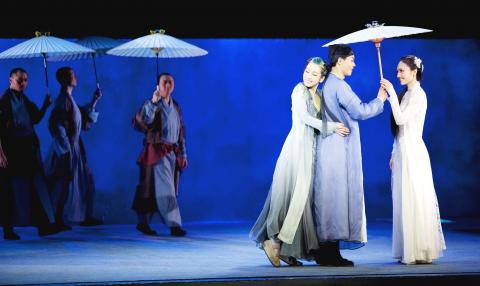Green Snake (青蛇) , the smash theater hit produced by China National Theater (中國國家話劇院), is a wild departure from its original source.
Legend of the White Snake (白蛇傳) narrates the romance between the demon White Snake and the handsome human scholar Xu Xian (許仙), as well as the quest of monk Fahai (法海) to break up the forbidden love. It’s a chaste romance, and Green Snake is strictly not.
“This is a story about seduction,” Tian Qinxin (田沁鑫), the play’s director, told the Taipei Times in a phone interview.

Photo courtesy of Taipei Arts International Association
Adapted from the acclaimed novel by Hong Kong novelist Lilian Lee (李碧華), Tian’s play turns the spotlight to Madame White Snake’s faithful companion, Green Snake, who also craves human love — and sex.
Jealous of the relationship between White Snake and Xu Xian, Green Snake is willing to forsake her immortality to steal him, leading to a disastrous romantic triangle. White Snake seduces Xu Xian to save her marriage, while Fahai seduces Xu Xian in an attempt to break up the taboo marriage. The play unfolds like a psychological drama, filled with anger, lust and temptation.
Chinese thespian Qin Hailu (秦海璐), who has won three Golden Horse Awards, takes the leading role of Green Snake in a sultry performance that was well-received in China and Hong Kong.
The cast also includes actress Jin Ge (金戈) as Lady White Snake, Dong Chang (董暢) as the handsome male scholar Xu Xian and Xin Baiqing (辛柏青) as the monk Fahai. There are three shows from Aug. 9 to Aug. 11 at the National Theater Taipei. Performances are in Mandarin, with Chinese and English subtitles.

Many people noticed the flood of pro-China propaganda across a number of venues in recent weeks that looks like a coordinated assault on US Taiwan policy. It does look like an effort intended to influence the US before the meeting between US President Donald Trump and Chinese dictator Xi Jinping (習近平) over the weekend. Jennifer Kavanagh’s piece in the New York Times in September appears to be the opening strike of the current campaign. She followed up last week in the Lowy Interpreter, blaming the US for causing the PRC to escalate in the Philippines and Taiwan, saying that as

Taiwan can often feel woefully behind on global trends, from fashion to food, and influences can sometimes feel like the last on the metaphorical bandwagon. In the West, suddenly every burger is being smashed and honey has become “hot” and we’re all drinking orange wine. But it took a good while for a smash burger in Taipei to come across my radar. For the uninitiated, a smash burger is, well, a normal burger patty but smashed flat. Originally, I didn’t understand. Surely the best part of a burger is the thick patty with all the juiciness of the beef, the

This year’s Miss Universe in Thailand has been marred by ugly drama, with allegations of an insult to a beauty queen’s intellect, a walkout by pageant contestants and a tearful tantrum by the host. More than 120 women from across the world have gathered in Thailand, vying to be crowned Miss Universe in a contest considered one of the “big four” of global beauty pageants. But the runup has been dominated by the off-stage antics of the coiffed contestants and their Thai hosts, escalating into a feminist firestorm drawing the attention of Mexico’s president. On Tuesday, Mexican delegate Fatima Bosch staged a

Would you eat lab-grown chocolate? I requested a sample from California Cultured, a Sacramento-based company. Its chocolate, not yet commercially available, is made with techniques that have previously been used to synthesize other bioactive products like certain plant-derived pharmaceuticals for commercial sale. A few days later, it arrives. The morsel, barely bigger than a coffee bean, is supposed to be the flavor equivalent of a 70 percent to 80 percent dark chocolate. I tear open its sealed packet and a chocolatey aroma escapes — so far, so good. I pop it in my mouth. Slightly waxy and distinctly bitter, it boasts those bright,